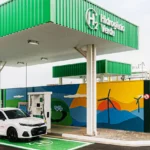The bioeconomy in Amapá represents a unique opportunity for the state to exploit its vast biodiversity in a sustainable way, driving economic development while preserving its rich environmental heritage. Situated in the heart of the Amazon, Amapá stands out as one of the most promising states to lead initiatives that integrate environmental conservation and economic growth.
Potentials
Among Amapá's greatest assets is the production of açaí, which in 2021 reached 43 thousand tons, generating up to 100 thousand direct and indirect jobs. In addition, the state has resources such as Brazil nuts, pirarucu and phytotherapeutic products, which have great potential to boost the local economy through sustainable production chains.
The development of the State Plan to Support the Sociobioeconomy, with the support of international partners such as the GCF Task Force and USAID, marks an important step in structuring this new economy. This plan includes the identification and mapping of the state's biological resources, promoting the integration of scientific knowledge with the traditional knowledge of indigenous communities. The expectation is that these actions will be presented during COP 30, placing Amapá in the spotlight on the global stage.
Challenges and opportunities
Although Amapá has enormous potential, there are challenges to be faced, such as the need to improve infrastructure and train local communities so that they can actively participate in production chains. However, these challenges also represent opportunities for growth and development.
The construction of an adequate infrastructure for the flow of products and the creation of public policies that encourage innovation and local entrepreneurship are essential. The bioeconomy in Amapá is not only an economic alternative, but a development strategy that promotes social inclusion, environmental conservation and the appreciation of traditional knowledge.
Development proposals
To overcome these challenges, it is essential to adopt an approach that involves all sectors of society. Amapá has already taken important steps in this direction, such as the development of an action plan that seeks to attract investment for sustainable production chains and the creation of financial mechanisms that allow the connection between local producers and global markets.
Furthermore, it is crucial to foster public-private partnerships and strengthen cooperation with research institutions to develop new technologies that can be applied to the sustainable exploitation of natural resources. Amapá's success in building a robust and sustainable bioeconomy can not only transform the state's economy, but also serve as a reference for other regions in Brazil and the world.
The bioeconomy in Amapá has the potential to transform the state into a leader in the integration of environmental conservation and economic development. With appropriate public policies, strategic investments and the active participation of local communities, Amapá can not only overcome the challenges it faces, but also pave the way for a future where sustainability and progress go hand in hand.
Find out how BRING can help your business embrace opportunities in the Northeast. Talk to our consultants!


